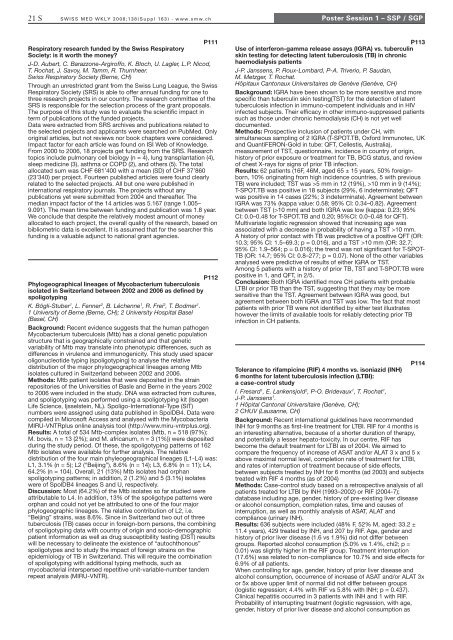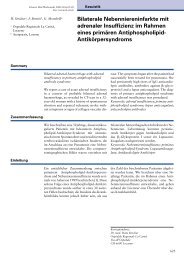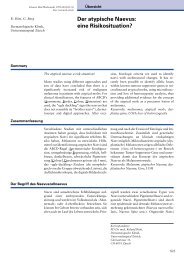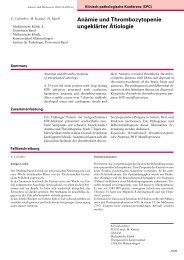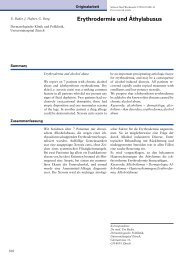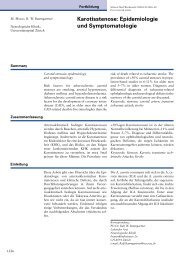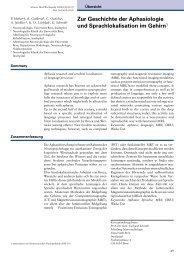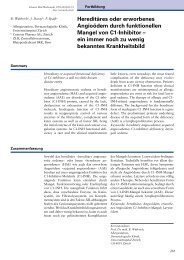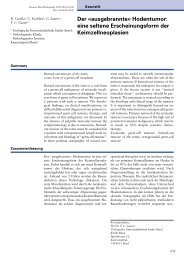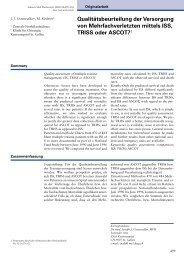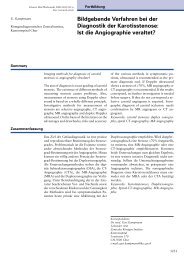Supplementum 163 - Swiss Medical Weekly
Supplementum 163 - Swiss Medical Weekly
Supplementum 163 - Swiss Medical Weekly
Create successful ePaper yourself
Turn your PDF publications into a flip-book with our unique Google optimized e-Paper software.
21 S SWISS MED WKLY 2008;138(Suppl <strong>163</strong>) · www.smw.ch<br />
Poster Session 1 – SSP / SGP<br />
P111<br />
Respiratory research funded by the <strong>Swiss</strong> Respiratory<br />
Society: is it worth the money?<br />
J-D. Aubert, C. Barazzone-Argiroffo, K. Bloch, U. Lagler, L.P. Nicod,<br />
T. Rochat, J. Savoy, M. Tamm, R. Thurnheer.<br />
<strong>Swiss</strong> Respiratory Society (Berne, CH)<br />
Through an unrestricted grant from the <strong>Swiss</strong> Lung League, the <strong>Swiss</strong><br />
Respiratory Society (SRS) is able to offer annual funding for one to<br />
three research projects in our country. The research committee of the<br />
SRS is responsible for the selection process of the grant proposals.<br />
The purpose of this study was to evaluate the scientific impact in<br />
term of publications of the funded projects.<br />
Data were extracted from SRS archives and publications related to<br />
the selected projects and applicants were searched on PubMed. Only<br />
original articles, but not reviews nor book chapters were considered.<br />
Impact factor for each article was found on ISI Web of Knowledge.<br />
From 2000 to 2006, 18 projects get funding from the SRS. Research<br />
topics include pulmonary cell biology (n = 4), lung transplantation (4),<br />
sleep medicine (3), asthma or COPD (2), and others (5). The total<br />
allocated sum was CHF 681’400 with a mean (SD) of CHF 37’860<br />
(23’340) per project. Fourteen published articles were found clearly<br />
related to the selected projects. All but one were published in<br />
international respiratory journals. The projects without any<br />
publications yet were submitted from 2004 and thereafter. The<br />
median impact factor of the 14 articles was 5.167 (range 1.005–<br />
9.091). The mean time between funding and publication was 1.8 year.<br />
We conclude that despite the relatively modest amount of money<br />
allocated to each project, the overall quality of the research, based on<br />
bibliometric data is excellent. It is assumed that for the searcher this<br />
funding is a valuable adjunct to national grant agencies.<br />
P112<br />
Phylogeographical lineages of Mycobacterium tuberculosis<br />
isolated in Switzerland between 2002 and 2006 as defined by<br />
spoligotyping<br />
K. Bögli-Stuber1 , L. Fenner2 , B. Léchenne1 , R. Frei2 , T. Bodmer1 .<br />
1 University of Berne (Berne, CH); 2 University Hospital Basel<br />
(Basel, CH)<br />
Background: Recent evidence suggests that the human pathogen<br />
Mycobacterium tuberculosis (Mtb) has a clonal genetic population<br />
structure that is geographically constrained and that genetic<br />
variability of Mtb may translate into phenotypic differences, such as<br />
differences in virulence and immunogenicity. This study used spacer<br />
oligonucleotide typing (spoligotyping) to analyse the relative<br />
distribution of the major phylogeographical lineages among Mtb<br />
isolates cultured in Switzerland between 2002 and 2006.<br />
Methods: Mtb patient isolates that were deposited in the strain<br />
repositories of the Universities of Basle and Berne in the years 2002<br />
to 2006 were included in the study. DNA was extracted from cultures,<br />
and spoligotyping was performed using a spoligotyping kit (Isogen<br />
Life Science, Ijsselstein, NL). Spoligo-International-Type (SIT)<br />
numbers were assigned using data published in SpolDB4. Data were<br />
compiled in Microsoft Access and analysed with the Mycobacteria<br />
MIRU-VNTRplus online analysis tool (http://www.miru-vntrplus.org).<br />
Results: A total of 534 Mtb-complex isolates (Mtb, n = 518 (97%);<br />
M. bovis, n = 13 (2%); and M. africanum, n = 3 (1%)) were deposited<br />
during the study period. Of these, the spoligotyping patterns of 162<br />
Mtb isolates were available for further analysis. The relative<br />
distribution of the four main phyleogeographical lineages (L1-L4) was:<br />
L1, 3.1% (n = 5); L2 (“Beijing”), 8.6% (n = 14); L3, 6.8% (n = 11); L4,<br />
64.2% (n = 104). Overall, 21 (13%) Mtb isolates had orphan<br />
spoligotyping patterns; in addition, 2 (1.2%) and 5 (3.1%) isolates<br />
were of SpolDB4 lineages S and U, respectively.<br />
Discussion: Most (64.2%) of the Mtb isolates so far studied were<br />
attributable to L4. In addition, 13% of the spoligotype patterns were<br />
orphan and could not yet be attributed to one of the four major<br />
phylogeographic lineages. The relative contribution of L2, i.e.<br />
“Beijing” strains, was 8.6%. Since in Switzerland two out of three<br />
tuberculosis (TB) cases occur in foreign-born persons, the combining<br />
of spoligotyping data with country of origin and socio-demographic<br />
patient information as well as drug susceptibility testing (DST) results<br />
will be necessary to delineate the existence of “autochthonous”<br />
spoligotypes and to study the impact of foreign strains on the<br />
epidemiology of TB in Switzerland. This will require the combination<br />
of spoligotyping with additional typing methods, such as<br />
mycobacterial interspersed repetitive unit-variable-number tandem<br />
repeat analysis (MIRU-VNTR).<br />
P113<br />
Use of interferon-gamma release assays (IGRA) vs. tuberculin<br />
skin testing for detecting latent tuberculosis (TB) in chronic<br />
haemodialysis patients<br />
J-P. Janssens, P. Roux-Lombard, P-A. Triverio, P. Saudan,<br />
M. Metzger, T. Rochat.<br />
Hôpitaux Cantonaux Universitaires de Genève (Genève, CH)<br />
Background: IGRA have been shown to be more sensitive and more<br />
specific than tuberculin skin testing(TST) for the detection of latent<br />
tuberculosis infection in immuno-competent individuals and in HIV<br />
infected subjects. Their efficacy in other immuno-suppressed patients<br />
such as those under chronic hemodialysis (CH) is not yet well<br />
documented.<br />
Methods: Prospective inclusion of patients under CH, with<br />
simultaneous sampling of 2 IGRA (T-SPOT.TB, Oxford Immunotec, UK<br />
and QuantiFERON-Gold in tube: QFT, Cellestis, Australia),<br />
measurement of TST, questionnaire, incidence in country of origin,<br />
history of prior exposure or treatment for TB, BCG status, and review<br />
of chest X-rays for signs of prior TB infection.<br />
Results: 62 patients (16F, 46M, aged 65 ± 15 years, 50% foreignborn,<br />
10% originating from high incidence countries, 5 with previous<br />
TB) were included; TST was >5 mm in 12 (19%), >10 mm in 9 (14%);<br />
T-SPOT.TB was positive in 18 subjects (29%, 6 indeterminate); QFT<br />
was positive in 14 cases (22%; 3 indeterminate). Agreement between<br />
IGRA was 73% (kappa value: 0.58; 95% CI: 0.34–0.82). Agreement<br />
between TST (>10 mm) and both IGRA was low (kappa: 0.23; 95%<br />
CI: 0.0–0.48 for T-SPOT.TB and 0.20; 95%CI: 0.0–0.48 for QFT).<br />
Multivariate logistic regression showed that increasing age was<br />
associated with a decrease in probability of having a TST >10 mm.<br />
A history of prior contact with TB was predictive of a positive QFT (OR:<br />
10.3; 95% CI: 1.5–69.3; p = 0.016), and a TST >10 mm (OR: 32.7;<br />
95% CI: 1.9–564; p = 0.016); the trend was not significant for T-SPOT-<br />
TB (OR: 14.7; 95% CI: 0.8–277; p = 0.07). None of the other variables<br />
analysed were predictive of results of either IGRA or TST.<br />
Among 5 patients with a history of prior TB, TST and T-SPOT.TB were<br />
positive in 1, and QFT, in 2/5.<br />
Conclusion: Both IGRA identified more CH patients with probable<br />
LTBI or prior TB than the TST, suggesting that they may be more<br />
sensitive than the TST. Agreement between IGRA was good, but<br />
agreement between both IGRA and TST was low. The fact that most<br />
patients with prior TB were not identified by either test illustrates<br />
however the limits of available tools for reliably detecting prior TB<br />
infection in CH patients.<br />
P114<br />
Tolerance to rifampicine (RIF) 4 months vs. isoniazid (INH)<br />
6 months for latent tuberculosis infection (LTBI):<br />
a case-control study<br />
I. Fresard1 , E. Lankensjold2 , P-O. Bridevaux1 , T. Rochat1 ,<br />
J-P. Janssens1 .<br />
1 Hôpital Cantonal Universitaire (Genève, CH);<br />
2 CHUV (Lausanne, CH)<br />
Background: Recent international guidelines have recommended<br />
INH for 9 months as first-line treatment for LTBI. RIF for 4 months is<br />
an interesting alternative, because of a shorter duration of therapy,<br />
and potentially a lesser hepato-toxicity. In our centre, RIF has<br />
become the default treatment for LTBI as of 2004. We aimed to<br />
compare the frequency of increase of ASAT and/or ALAT 3 x and 5 x<br />
above maximal normal level, completion rate of treatment for LTBI,<br />
and rates of interruption of treatment because of side effects,<br />
between subjects treated by INH for 6 months (ad 2003) and subjects<br />
treated with RIF 4 months (as of 2004)<br />
Methods: Case-control study based on a retrospective analysis of all<br />
patients treated for LTBI by INH (1993–2002) or RIF (2004-7);<br />
database including age, gender, history of pre-existing liver disease<br />
or alcohol consumption, completion rates, time and causes of<br />
interruption, as well as monthly analysis of ASAT, ALAT and<br />
compliance (urinary INH).<br />
Results: 636 subjects were included (48% F, 52% M, aged: 33.2 ±<br />
11.4 years), 429 treated by INH, and 207 by RIF. Age, gender and<br />
history of prior liver disease (1.6 vs 1.9%) did not differ between<br />
groups. Reported alcohol consumption (5.0% vs 1.4%, chi2; p =<br />
0.01) was slightly higher in the RIF group. Treatment interruption<br />
(17.6%) was related to non-compliance for 10.7% and side effects for<br />
6.9% of all patients.<br />
When controlling for age, gender, history of prior liver disease and<br />
alcohol consumption, occurrence of increase of ASAT and/or ALAT 3x<br />
or 5x above upper limit of normal did not differ between groups<br />
(logistic regression; 4.4% with RIF vs 5.8% with INH; p = 0.437).<br />
Clinical hepatitis occurred in 3 patients with INH and 1 with RIF.<br />
Probability of interrupting treatment (logistic regression, with age,<br />
gender, history of prior liver disease and alcohol consumption as


